| You have heard my story about Why Do Women Wear Hats in the Market Place
in Peru and that tale has now been told. It is time to move on to a unique new subject, the wonders of the Galapagos Islands.
The Galapagos are located about 800 miles, give or take a few, directly west of Ecuador. Half of the islands are north of the
equator and half south. This means you get to spend some of the time in the winter and some in the summer, depending upon where
you are. Since our trip was in June it was summer in the northern hemisphere and winter in the south. This caused all sorts of
problems with the dress code. We crossed the equator several times during our visit.
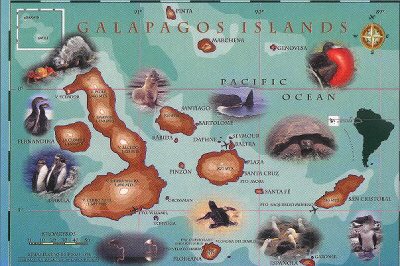 The Galapagos are a group of volcanic islands along a rift in the crust of the earth's floor under in the Pacific Ocean. Millions of years old they are. Because they are so isolated from any major continent their value has been the ability to study the development and evolution of the wild life on each of the separate islands. Inter-mingling of species doesn't take place and as a result scientists are able to study the changing of a specie based upon environmental factors. Also, because of the isolation many of the animals are not afraid of man which makes it a great place to visit. |
| This is a yellow iguana found only on the Galapagos islands. They grow large and sluggish because they have no natural enemies. They lay in the sun on the ground warming up every morning so they can start going. | 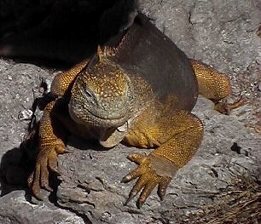 |
The iguana is this color because it eats the yellow petals from the Galapagos cotton trees. They are not slim and sleek because they don't have to scamper into the woods to avoid being eaten by some predator. |
| You have probably heard about the Galapogos because it was here that Charles Darwin started questioning the 19th century conventional wisdom that everything on the earth was created at the same time and is unchanging. The Galapagos Islands had been known for a long time by the sailors manning whaling vessels as a place to stop over and pick up fresh water and food. Today the islands are a protected sanctuary and very few people live there. Generally tourists are not allowed to stay on any of the islands but must arrive by boat and leave before nightfall on their boats. Tour groups are restricted: The group may consist of no more than 16 people and must be accompanied by a certified Naturalist. Right away you can see a problem arises if you are on a boat which carries more than 16 passengers. A large ship, of 125 passengers, may take all day just to give everyone a chance to visit the island. |
| Until WWII there was no airport on the Galapagos but the U.S. Navy corrected that problem in order to protect the Pacific against the Japanense fleet. Now everyone flys from Guayaquil, Equador, to Baltra Island. Upon landing you are immediately impressed with the emptiness of this place. We are taken by bus to our "ship", the Millenium, which will be home for the next 7 days. | 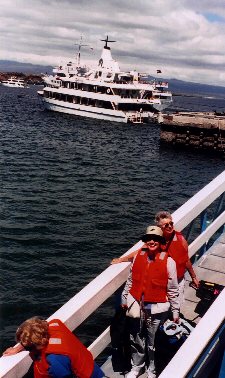 |
Here you see Fran, dressed in a stylish orange life jacket, being escorted down the gangway to our "tender" which will take us to the Millenium, seen in the background. Note the ship has three decks; two decks of cabins and the upper deck is an observation area. |
| As we board the ship we are asked to remove our shoes and leave them on the back deck for the rest of the trip - barefoot is the shoe wear we need on board. Before we are assigned our rooms our Naturalist, Roberto, who will be with us every day for the next seven days, gives everyone some basic instructions. Shoes which are worn on land can not be worn on the boat. They may scratch the beautiful parque floors but even worse, you may carry aboard some animal dung or other foul smelling debris which we may find objectionable. Considering how warm it is going barefoot is not a problem. Our shoes are always available in the back of the boat when we need them for hiking any of the islands. | 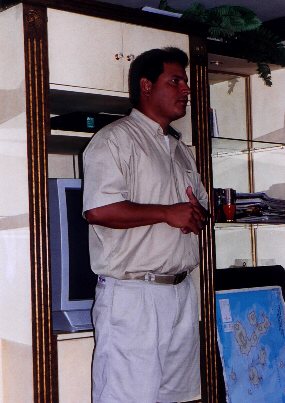 |
When Roberto was finished telling us the "rules of the ship" he then had the unpleasant duty of assigning cabins. "I don't like to be responsible for the cabin assignments", he says. He goes on to explain there are 10 cabins on board. 7 double cabins on the first deck (sea level) and three cabins on the second deck. The problem, he explains, is that two of the cabins on the second deck are really suites with a sitting room, king size bed, and a bathroom with a Jacuzzi. His recommendation is that we draw lots to see who gets the large suites. |
| We all anxiously put on names on a piece of paper and each hoped he would be the "lucky one." Fran and I lost. The winners, followed by everyone else, went up to see their suites. We were all amazed. Just plain fantastic is the only word to use. The losers then quietly went down to the first deck and moved into our small cabin with two twin beds, a private bath, and a balcony overlooking the ocean. | 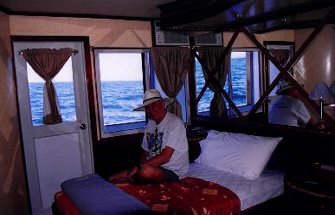 |
Our cabin on the Millenium was on the first deck at sea level right above the engines. Every room has a balcony. Our bath tub also overlooks the ocean through a full length, and width, bay window. The window slides open and if you are not careful you can fall into the ocean when you are taking your morning shower. A shower curtain is not necessary because there is nothing out there but a million miles of Pacific Ocean - except, as FranSabel learned one afternoon, when some fishermen come by in their row boat. |
That night we sailed north and crossed the equator for the first time. As we changed course and headed west toward
Isabella Island Roberto's prediction proved true to his word when he said, "It might get a little choppy". It seams that at this
time of year the wind blows to the south and the current runs to the north. The next morning we find out that the winners of the large
suites were really the losers. All night the top of the ship rocked back and forth. The higher you are, the more it rocks.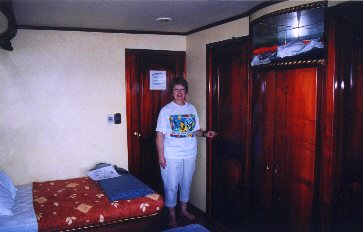 Imagine this: Their furniture was rolling across the floor all night long, from one sided of the cabin to the other. The occupants, when they got up to use the Jacuzzi'd bathroom, literally had to crawl on their hands and knees because they couldn't stand up. We found out why Roberto didn't want to be the one responsible for making these room assignments - they would have made him walk the plank. Suddenly Fran didn't think having to listen to the noise of the engines all night was so bad after all. Moral of the story: Volunteer to take the small cabin at water level. |
![]()
| Before I forget, I want to share some thoughts on the educational value of travel. For those of you who are television watchers, Shell Oil has a new ad which starts off with a single graceful white/yellow breasted frigate bird gliding high above the ocean. The speaker goes on to talk about how clean Shell gas is compared to other brands. The frigate bird is then shown sailing high above another wretched bird, feathers all a-mess, with a red breast but a similar looking beak, sitting on a crooked tree limb. The frigate bird then flies to an idealic green island filled with all sorts of other colorful birds. | 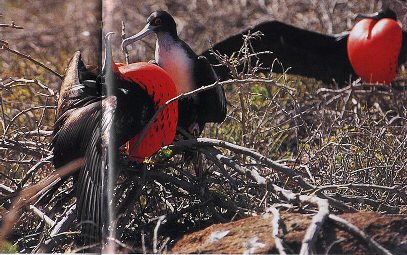 |
While on my cruise through the Galapagos I learned that the white/yellow breasted frigate bird is a female. The red breasted disheveled frigate bird is a male. Watch for the ad the next time it comes on. See how much more enjoyment I get out of a simple TV commercial? I wonder what kind of symbolism is meant here? There are many more wonders of nature which I will disclose to you as this story unfolds. |
| We flew from Guayaquil to Baltra where we were bused to our ship. As we got settled the ship set a course for our first stop, Bartholome. A very small, and young as time goes, volcanic island | 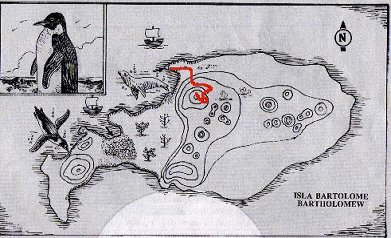 |
| A new volcanic island devoid of much vegetation. Lava lizards, which feed on insects, were the only visible life forms except for the sea lions which had scampered to the shore to bath in the warm sun. A few lava cacti plants were pointed out to us and it was explained that as these plants die they leave a tiny bit of soil which makes it possible for other plants to take root. | 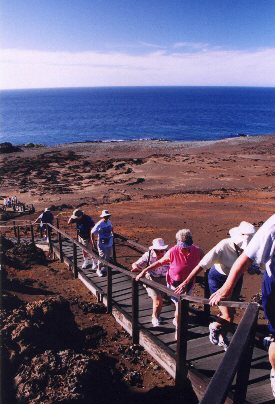 |
While on any of these islands we were required to remain on the paths laid out for the tourists and intended to preserve the surface. Here Fran stops for a "breather" as we climb the 365 steps up the side of Cerro Bartolome. |
| From the top of Cerro Bartolome you get a view of Sullivan Bay. You also see the spectacular lunar fields of dried lava, volcanic craters and Pennacle Rock. | 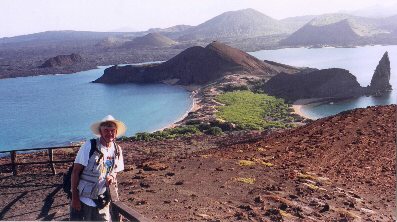 |
After returning to the Millenium we took our first swim in the ocean - the water temperature was a refreshing 74 degrees. |
| This is a rough map of Urbina Bay so you can get a feeling about where we hiked and what the geography was like. On these maps you may see elevation lines and I have drawn the path we followed around the area I have marked in red. |
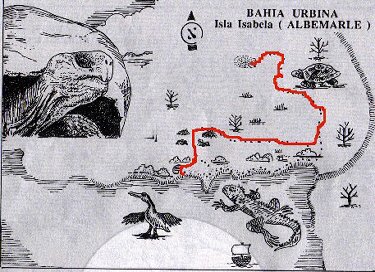 |
| The land here is flat and the diagram shows the kinds of animals you may expect to see - if you are lucky. The only wild life we saw were the yellow iguana. There are tortoises (as distinguished from turtles which are sea creatures) on the island but since this is the dry season they are generally found in higher altitudes. More on this subject later. |
| One confusing aspect of the Galapagos is that the islands were settled by both the Spanish and the British. Accordingly each island has both a Spanish and a British name. When you hear the name of an island you are never quite sure which one the speaker is talking about. This also makes it difficult to find the island in the guide books because they generally identified the island by its English name while Roberto, our Ecuadorian naturalist of Spanish ancestry, would use the Spanish name. Just made the trip all that more exotic. | 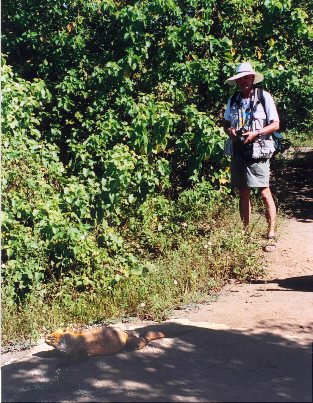 |
After a rough night of sailing (for those in the plush suites on the second deck) we landed at Urbana Bay on Isabela Island. Prior to 1950 this area was under the sea. Then an eruption of Alcedo volcano lifted the land more than 15 feet above sea level - thus we were shown dried coral and other sea organisms which were stranded by the sudden uplift. Here Bob looks at a massive yellow land iguana as it sleeps in our path waiting for the warm sun. |
| GOATS BEWARE! The entire Galapagos archipelago is a protected area and the intent is to allow the endemic plants and animals to develop. In the 16th, 17th, and 18th century the Galapagos were visited by many sailing vessels and numerous attempts to settle here were abandoned. The climate and soil is too harsh. When the people abandoned the islands, however, they left their livestock which frequently included goats. | 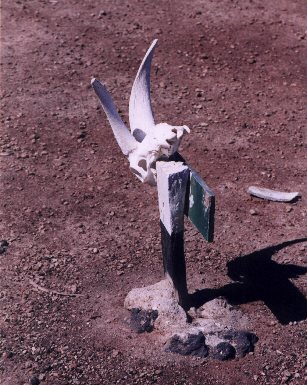 |
The goats thrived but they "are killing the iguana and the tortus" we are told. Actually the goats don't kill the iguana or anything else; but they cause the death of many species of reptiles because they are much more mobile and compete for the same food and the reptiles die. So, there is open season on wild goats. On one island alone they killed over 700,000 goats. Here you see the horns of a goat placed upon a typical wooden stake which is used as a path marker for the naturalists as they guide us across the barren land. |
![]()
| After our walk through the island we stopped for a swim in the bay. We took our snorkel and mask so we could see some of the underwater life. Unfortunately the waves were coming in and the water was stirred up and we couldn't see much. |
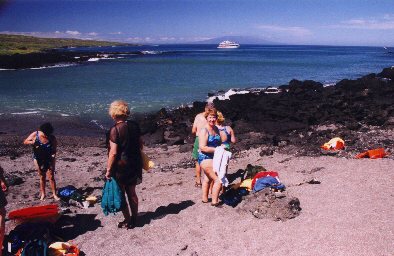 |
| You can see how the lava from the volcano flows right to the sea and only a small portion of the bay is sand. To the left of the picture - which you can't see - is a turtle nesting ground. This area is marked off so you don't inadvertunately walk into the area where the turtle eggs are buried. |
![]()
| Everyone asks, "Which one was your favorite island?" This is not a fair question because they were all great but they were all different and yet all the same. Such mysteries. On some islands we made several stops at a different landing site or a unique cove. In my memory, the landing at Tagus Cove on Isabela stands out as the most remarkable, so please allow me the luxury of spending some time talking about this remarkable sheltered cove. |
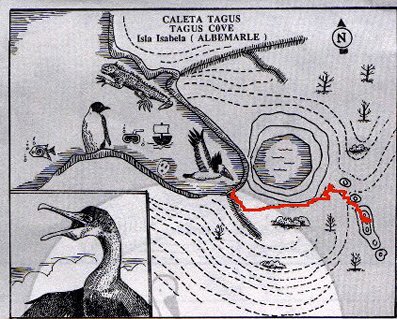 |
| All of the islands are volcanic in origin and Tangus Cove seemed to have the widest diversity of geology, plants and animals of all the places we visited - or maybe this was really the first of the real exotic landings and thus I was most impressed. Tangus Cove was a "dry landing". This means we rode the dingy to shore and were able to step onto dry land. Urbina Bay was a "wed landing" which means the dingy was pulled onto a sandy beach but we stepped out into the water, never more than knee deep, but we had to wear shoes or sandals which could be gotten wet. |
| As our dingy pulled up to the rocky shore of Tangus Cove we saw our first "wingless" or "flightless" cormorant. "Use them or lose them" was the evolutionary lesson taught by our Naturalist. The cormorant has no natural enemies and thus can nest on the shore and swim right up to land and walk out of the water. Since it lost the need to fly it also, over the centuries, lost the use of its wings. The rule might be said a ifferent way, "If you don't need them, over time you will lose them." | 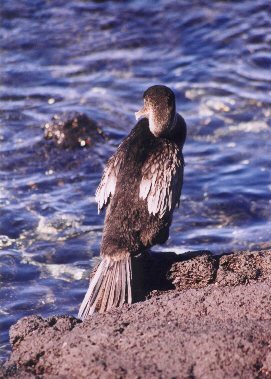 |
There are only some 700 pairs of wingless cormorants in existence and they are unique to only a couple of the the Galapagos Islands. With no enemies to fear it does not suffer from the inability to fly. It is a good diver and can easily catch the fish it needs for food. |
| As I mentioned before, there is a definite advantage to traveling on a small ship in the Galapagos. Since each group must have a Naturalist and no group can be larger than 16 people we were in great shape. We would be transported to land in a rubber dingy in two separate shifts. The first group to arrive would wait on shore for the second increment to arrive and then we could all take off together for our exploration of the island. Walking on these islands is not always easy. For instance, upon landing at Tagus cove our first obstacle was to work our way around this sea lion. | 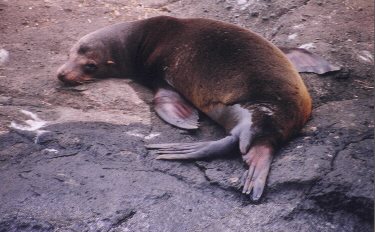 |
The second rule we learned from Roberto was: "Do not touch any of the animals". "They are allowed to touch you, but you can not touch them." So a sea lion sleeping in our path had to be skirted around. This was not always easy because sometimes the path was very narrow with steep embankments on both sides. Do you know how to tell the difference between a sea lion and a seal? Easy: a sea lion has ears. Just look and see. |
| Once we got around the sea lion we started our long trek up the side of the volcano on a narrow path. Half way up we could look back to see the cove and the crater lake filled with brackish water. The lake was once connected to the ocean and then rose up during another volcanic eruption. As we walked up we met another group from the other ship in the bay coming down. |
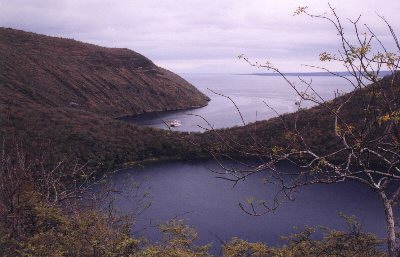 |
| You can see the Millenium to the left of the cove and to the right, further out to sea, close to the twig on the tree, is a much larger ship which held 125 passengers. Since they were limited to disembarking only 16 people with a naturalist, and 30 minutes had to be given between each landing party, they took the whole day just to see this one cove. For us, however, it was our second stop. We had visited Urbina Bay in the morning, returned to our ship, had lunch, and took a nap while our skipper sailed for 1.5 hours to Tagus Cove. So, the larger ships would frequently only see one landing site a day where we would see two, or possibly three. Notice the clouds in the sky? It didn't rain but this becomes important later. |
| We hike up a narrow dirt, gravel, rock and lava path high above the cove. Just as we were out of breath, and swore we could climb no higher, Roberto would stop and give us a description of the flora surrounding us. Each island started as bare volcanic rock slowly growing until it poked its cone above the surface of the sea and grew higher and higher. At this latitude the air is very dry and only has rain a couple months of the year during the rainy season. First lava cactus and then other plants would find a way to take root. The Christ tree, from which incense is made, flowers and has leaves only 3 months a year. The rest of the time it looks dead. Plants, like animals, had to adapt to survive. |
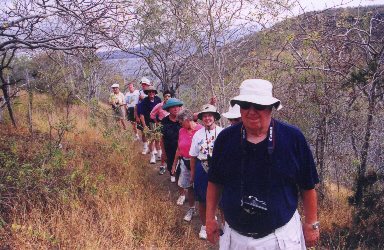 |
| By the time Roberto finished his explaination we were rested and he would start us up the trail once more. Trees which produced seeds had to develop hard shells to keep the birds from eating them. The birds, most notably the Darwin finches, 13 different species all evolving from a single ancestral group, had to develop strong beaks to break open these shells to get to the seed inside. Birds which were able to do this survived and prospered and the other ones died. It would not be unusual for an island to go without rain for a year or more which in turn challenged the species even more. Those most suited to the changing natural environment passed on those characteristics and survived. |
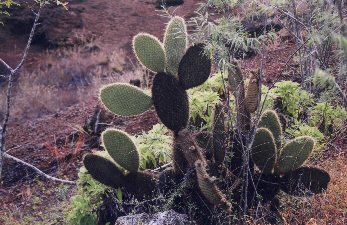 |
| After about a one hour up hill hike - I can't honestly say it was a climb although it felt like it - we reached the summit of the volcano where we can overlook the lava fields on Isabela. As you can see from the photo lava rock is very sharp and crunches below your feet as you walk. | 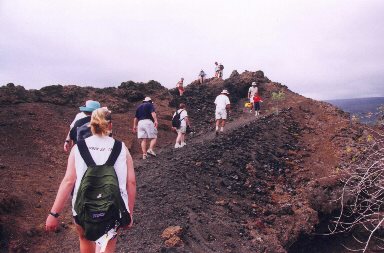 |
| Naturally I took lots of pictures, none of which can do the scenery justice, and in this photo you can hardly see anything - the sky was overcast so it, and the ocean in the distance, was gray and the lava rock is black. From this vantage point we could see the cone of Darwin volcano which reaches 4,200 feet above sea level. |
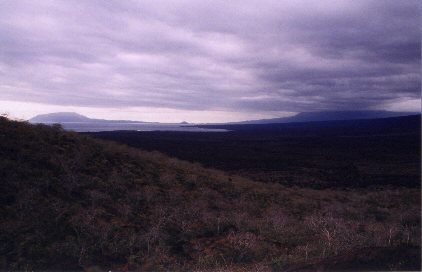 |
| You can see where the lava flows came down the side of the volcanoes and flows to the sea. The top of Darwin volcano is covered in clouds. The islands can have six different vegetation zones. Low islands are the driest because the clouds pass by without discharging any rain. Mountainous islands often have black clouds over them which turn into fog, drizzle or a little rain shower which helps flora survive. Remember this picture of the Darwin volcano with the black cloud covering its summit when I tell you later about the unique giant tortoises living on these islands. |
![]()
| While reading about my adventures you are probably wondering, "What does one wear while on such an exploration. This photograph will try to answer some of your questions. Naturally a hat is essential to keep the sun off your face. Some people also wear sun glasses but I find they get in the way of taking pictures. A short sleeve shirt with a multi-pocketed vest to carry extra film, batteries, telephoto lenses, water jugs, and maps is useful. Long trousers which zip off into shorts are useful - especially if you have handsome legs. The zipped off legs can fit into the back of the vest. Tennis shoes, or hiking boots, are best for walking over the hard coral and rough surfaces. I had both and every day I would ask Roberto which one would be better. Sometimes sandals is all we needed. | 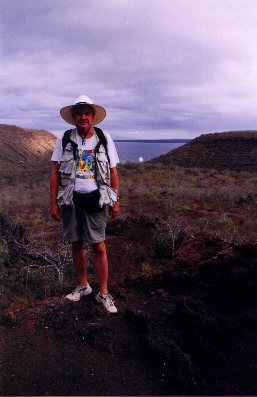 |
I also carried a back pack with extra camera equipment. You don't want to get stuck in a remote area only to find you ran out of film and you left some more in your "state room" on the ship. Sometimes we carried a walking stick which worked well as a third leg to balance yourself when walking over a path consisting mostly of uneven rocks. Paved walks are non-existent. Here I am standing at the top of the volcano on Isabela overlooking Tagus Cove. You can see the Millenium in the bay beyond. |
| Once we maneuvered our way down the mountain to sea level the second stage of our adventure at Tagus Cove began. We took a dinghy ride along the edge of the cove to see the sea animals as they rested between fishing trips. Since our ship can not land on any island the dinghy became an essential taxi between ship and shore. Here you can see Fran showing us what the well dressed traveler wears on a dinghy ride. First you make sure you wear shoes that could get wet, or go barefoot if it is going to be a wet landing which means you carried your shoes. Everyone, except Roberto and the dinghy crew, wears the fashionable orange life vest so you can be spotted if your fall into the water - an unlikely event. | 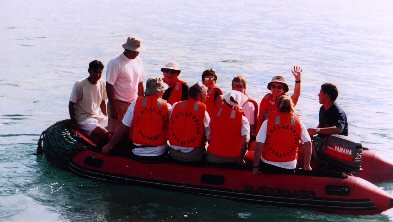 |
| On the dinghy ride along the rocky cliffs boarding Tagus Cove we saw the rare Galapagos penguin. These are the most northerly penguin species probably brought up originally by the Humboldt Current. We are told, "El Nino is killing the Penguins." Once again the statement is true but also misleading. Like the problems with the goats, it isn't El Nino's warm water that kills the Penguins, it is the effect of the warm water that does it. The Penguin feeds on fish and has a limit to the depths it can dive to catch those fish. | 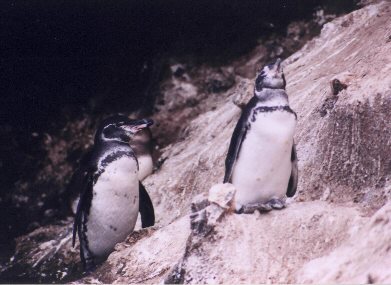 |
The water in the Galapagos has several layers of warmth, each one only being four or five feet deep. When you swim in the ocean you can literally see the different layers; they appear as a blurring wave in the water. When El Nino arrives the water warms and the fish go deeper to stay with the cooler waters. When the fish go deeper they go beyond the depths a penguin can dive. If the penguin can't find food it will starve. Once again, those Penguins which develop the ability to dive deeper will survive - but evolutionary change comes slowly and may not be fast enough to save the small Penguin population in the Galapagos. |
| It is at Tagus Cove that we got our first close up view of the infamous blue-footed boobie. To see these odd looking sea birds for the first time was a real thrill. You will see more about them in a later message. Also in this scene you can see the common bright yellow and orange Sally Lightfoot crab. They can be seen on almost every rock along the coast line in the Galapagos. | 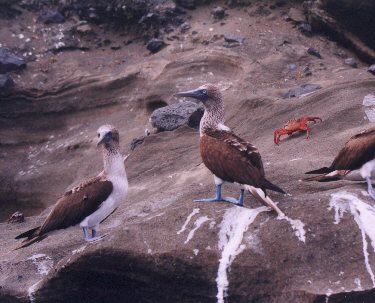 |
The sight of sea lions sleeping on the rocks became common place. As we took our dinghy ride we saw sea lions and penguins swimming and diving in the water around us. Blue-footed boobies would fly overhead and suddenly tuck in their wings and dive like a bullet into the water as they searched for fish. Pelicans were also common. The glory of nature was everywhere. Oh what a day, I hoped it would never end. |
| As we rode our dinghy back to the Millenium we looked up at the cliffs high above us. The cliffs appeared to be similar to the limestone cliff we see in the U.S. Layer upon layer of soil - this seemed odd for an island created by volcanic action. Roberto explained that this was volcanic ash laid down in layers as the volcano erupted. Eventually the island rose above sea level and after thousands of years of erosion this is what you see. |
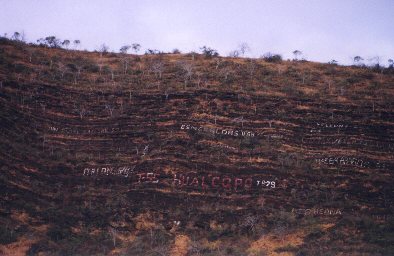 |
| Charles Darwin landed in Tagus Cove and spent 6 weeks in this area studying the finch population. The cove was historically used as an anchoring site for pirates and whalers. After having spent a rough night the day before I can understand the need for an anchoring site protected from the rough ocean. You can see the names of hundreds of ships sculpted and painted on the high ridge. |
| This was an exciting day, how could it get any better? Could there be more? When we returned to our ship we were then treated to a delicious dinner. We were provided three hardy meals a day and each one was superb and worthy of the largest luxury cruise ship. Three booths were set up in the dinning area and we could sit with a different group every meal. This made the trip even more interesting and made lasting friendships. | 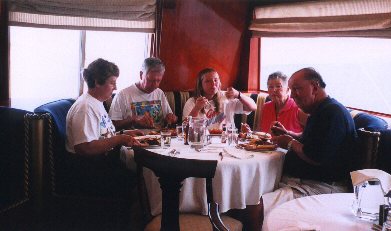 |
| So in one day we visited Urbina Bay and saw giant yellow iguana and swam in the bay; in Tagus Cove we saw sea lions, volcanoes, penguins, boobies, cormorants, and autographed cliffs. Could it be any better? Well, yes! As the sun went down the skies cleared of clouds and we had a perfectly black moonless night. As I looked into the sky I could see the Southern Cross. |
 |
| Oh what a joy for someone who had learned the constellations of the northern hemisphere as a boy scout and who had studied astronomy in college. I Went to bed with a full stomach and a happy heart. Could it get any better than this? |
| Yes it did. I woke up at midnight and poked my head out onto our deck overlooking the Pacific. The sky was clear and I had to see it once more. So I grabbed a flashlight to make my way through the dark ship and climbed the ladders up two decks to the observation deck. |
 |
| There it was, I could see it cover the sky from horizon to horizon, the Milky Way. You haven't lived until you have seen "The Backbone of Night" on a clear night in the middle of the Pacific ocean unobstructed by any lights from shore or the ship. Now my day was complete and I slept soundly until our alarm went off at 5:30 a.m. and the next day's adventure started. |
Marie, our resident poet, described the day so much better:
If you have any questions about what you are seeing, or want some further information, feel free to
send me a note. 
If you are looking for a good tour book I recommend Ecuador & Galapagos published by Insight Guides. Although it covers a lot of Ecuador it has the greatest explaination and photographs of the Galapagos Islands. I bought my copy at Barnes and Nobel Bookseller after I returned.

Since October 19, 2002, you are visitor: